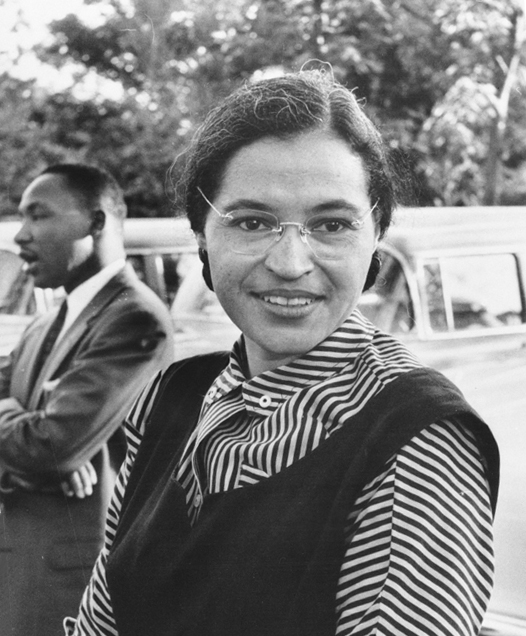For nearly a century after emancipation, black people couldn’t eat at the same restaurants, use the same toilet facilities, stay at the same hotels, go to the same schools as whites, or live in certain places. Towns across the South and the Southwest had “sundown laws, which meant that a black person was not allowed in those communities after sunset. Interracial marriage was illegal and most black people couldn’t vote because they were unable to pass voter literacy tests or afford the “poll tax,” which was a fee to vote.
On December 1, 1955, a 42-year-old woman named Rosa Parks refused to give up her assigned segregated seating at the back of a Mongomery, Alabama bus to a white man and was subsequently arrested. Thus the Civil Rights Movement had begun.

Black community leaders formed the Montgomery Improvement Association (MIA) led by Baptist minister Dr. Martin Luther King, Jr., who went on to play a pivotal role in the fight for justice and equality for black.
The MIA staged a boycott of the Montgomery bus system, which lasted 381 days. On November 14, 1956, the Supreme Court ruled segregated seating was unconstitutional.
On September 3, 1957, nine black students, known as the “Little Rock Nine,” arrived at Central High School in Little Rock, Arkansas. The U.S. Supreme Court had previously ruled that school segregation was illegal in the case of “Brown Vs. Board of Education.”
Unfortunately, they were met by the Arkansas National Guard, on the order of Governor Orval Faubus, and a screaming, menacing mob. The Little Rock Nine tried again a few weeks later and made it inside, but had to be removed for their safety when violence erupted. President Eisenhower dispatched federal troops to escort the students to and from classes.
President Eisenhower signed the Civil Rights Act of 1957 into law on September 9, 1957. It was the first major civil rights legislation since Reconstruction. The new law provided federal protection of voting rights.
Thirteen “Freedom Riders,” comprised of seven black and six white activists, boarded a Greyhound bus on May 4, 1961, in Washington, D.C., commencing a bus tour of the American South to protest segregated bus terminals. In 1960, the Supreme Court had ruled this was illegal in the case of “Boynton Vs. Virginia.” On Mother’s Day 1961, the bus reached Anniston, Alabama, where an angry mob mounted the bus and threw a bomb into it. The Freedom Riders managed to escape the burning bus, but were savagely beaten.
The Riders were unable to find a driver to complete their journey, so Attorney General Robert F. Kennedy intervened. They continued their journey under police escort on May 20th, however, the officers left the group once they reached Montgomery, where a white mob viciously attacked the bus.
Responding to pleas from the riders and Dr. Martin Luther King, Jr., RFK sent federal marshals to Montogomery, Alabama. In the fall of 1961, the Interstate Commerce Commission issued regulations prohibiting segregation in interstate transit terminals.
One of the most notable events of the civil rights movement took place on August 28, 1963. This was the “March on Washington,” which was a peaceful march involving 200,000 people of all races. The keynote speaker was Dr. King, who gave his famous “I have a dream” speech.
The Civil Rights Act of 1964, signed by President Lyndon Johnson, secured African Americans access to restaurants, transportation, and other public facilities. It also enabled black, women, and other minorities equal opportunity in the workplace.
On March 7, 1965, 600 peaceful demonstrators took part in a march from Selma to Montgomery to protest the killing of Jimmy Lee Jackson, a black civil rights activist killed by a white policeman.
As the protesters approached the Edmund Pettus Bridge, they were blocked by Alabama state and local police sent by Alabama governor George C. Wallace, who was a vociferous opponent of desegregation. The protesters continued marching and were ruthlessly beaten and tear-gassed by law enforcement. A number of protesters were hospitalized. Among them was John Robert Lewis, who suffered a skull fracture. Lewis went on to serve in the U.S. House of Representatives from 1987 until his death on July 17, 2020.
The incident was televised and became known as “Bloody Sunday.” Some activists wanted to retaliate with violence, but Dr. King urged nonviolent protests and was able to obtain federal protection for another march.
President Johnson signed the Voting Rights Act of 1965 into law on August 6, 1965. The law banned all voter literacy tests and provided federal oversight of elections. The Supreme Court ruled poll taxes were illegal in “Harper Vs. State Board of Education” in 1966.
Iconic civil rights leader and Nobel Peace Prize recipient, Dr. Martin Luther King Jr. was assassinated on April 4, 1968. Protests, looting, and rioting ensued, prompting The Johnson administration to push through additional civil rights laws.
The Fair Housing Act was signed into law on April 11, 1968, a week after King’s assassination. It prevented housing discrimination based on race, sex, national origin, or religion.
The valiant and heroic efforts of civil rights activists and thousands of protesters of all races, religions, and creeds paved the way for equality and social justice, not just for black Americans, but for all Americans.










